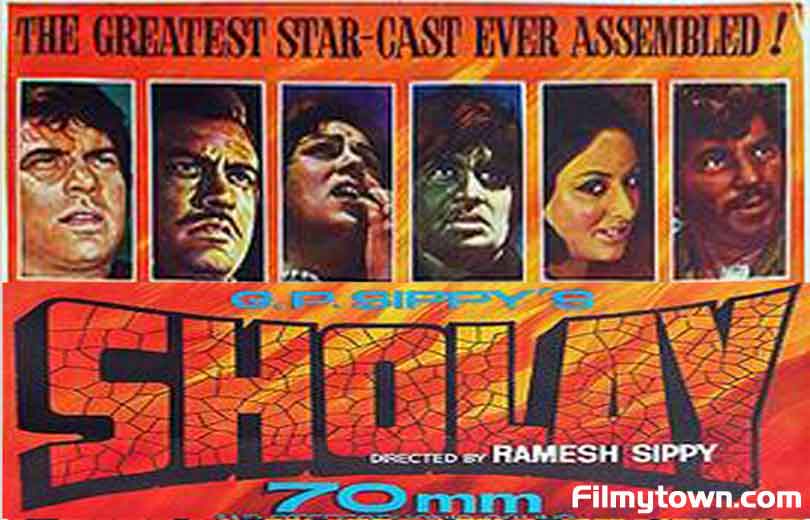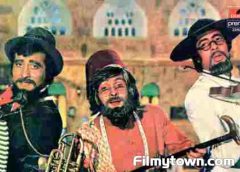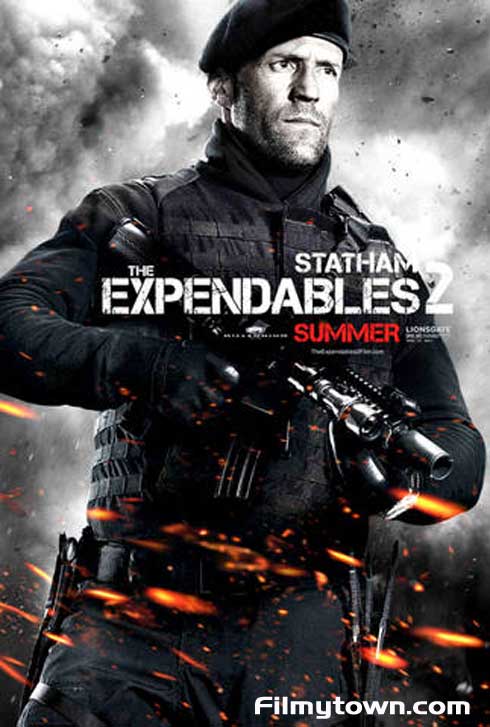Sholay (1975) was not just a movie, but a full scale audio and visual experience which was absolutely new to the Indian audience in the seventies and it was not just about achieving perfection in all departments.
Be it casting, acting, direction, a balanced story, fantastic screen-play and out of the world dialogues, but it had something absolutely novel to offer the Indian audience for the first time, a wide screen experience. Indian cinema was hitherto been confined to a 35MM screen almost squarish and no one had experimented with the 70mm visual delight it just created magic.
The year was 1975 and Sholay was released on 15th August, the Independence Day. It’s first week was dull as in those times the dacoit films was an oft repeated formula. It is also rumored that it was a sort of remake of a 1971 dacoit drama Raaj Khosla’s ‘Mera Gaon Mera Desh’ with even the name of the main villain sounding similar Jabbar to that of Gabbar in Sholay.
Ramesh Sippy the young director had taken a big risk with much at stake for his father G.P. Sippy’s banner which was by then well established for over two decades and had a reputation to keep. Though he had already helmed some super-duper hit projects like Andaaz and Sita aur Geeta (the movie which propelled Hema Malini to super stardom) still the main villain of the story Amjad Khan was a totally unknown quantity and for once the villain was the main pivot on which the film was balanced add to that the experimentation with 70MM and stereo sound.
But as the word spread the audiences came in droves to cinema halls where ever it was running it ran to packed houses for not weeks, months but for years, so much so that it created a record of longest running movie in one cinema hall namely Minerva in Mumbai for more than 300 weeks (over six years).
This was one movie whose characters, whose dialogues were a rage so much so that for the first time cassettes of its dialogues were sold by the millions. It is also probably the first movie which brought the concept of movie merchandising to India.
Sholay’s popularity was such that the tickets were sold in black market for over 20 times the ticket price and mind you those were emergency days in India and any kind of black marketing was a taboo. Not only the makers and the stars of this movie were enriched but it made millionaires out of all sorts of black marketers, the cinema hall attendants, taxi drivers etc.
Coming to the story of the movie itself, it is a simple story of revenge of a retired police officer Thakur played by (Sanjeev Kumar – just superb) against a dacoit Gabbar Singh (the menacing Amjad Khan who changed the definition of villainy) whom he had put behind bars. Gabbar escapes and polishes off Thakur’s family including a young boy, leaving only the Thakur whose hands he cuts-off as punishment of his incarceration and Thakur’s younger son’s widow (Jaya Bhaduri-Stoic).
Now Thakur is baying for his blood even as Gabbar has become a terror in the surrounding villages who collects his own taxes from the villagers and is generally menacing as he raids and pillages any village at his will.
Thakur is looking for an opportunity and is on a look-out for two particular convicts Jai (Amitabh-excelled in some scenes) and Veeru (Dharmendra- who held the enterprise together and provides much of the comic relief) who have just completed their sentence and are also on a look out for a new con job.
Thakur has had a run in with them and admired their courage and truthfulness. He hires them for a hefty some to capture Gabbar and hand him over, from there the cat and mouse game begins between good, bad and the ugly. Before the climax it is interspersed by many endearing sub plots and fantastically picturized scenes.
Apart from the main leads this movie created some evergreen characters such as the Blabbermouth Basanti (Hema Malini-no one can be imagined apart from her), Jailor (Asrani-perfect slapstick), Soorma Bhopali (Jagdeep-Hilarious), Imam Saheb (A.K. Hangal), Kaalia (Viju Khote) and Sambha (Mac Mohan) -Gabbar’s henchmen, Mausi (Leela Mishra) and even Thakur’s servant Ramlal ( Satyen Kappoo) were discussed and talked about in every forum .
So much so that even the mute domesticated animals like Dhanno (the mare) were a rage. Coming tp some particular scenes such the tax refusal by Thakur, his exchange with Kaalia, the subsequent shooting of the three henchmen, the marriage proposal scene of Jai with Mausi and the water tank scene where a drunk Veeru feigns suicide as his proposal for marriage to Basanti is refused, Dhanno saving Basanti from the dacoits, the holi song and aftermath scene were iconic and perfectly timed like clockwork.
The story, screenplay and immaculate dialogues were written by the fabulous duo of Salim Javed. Everything about the movie including its songs were flawless, such movies happen once in a century. It is still worth a dekko and re-dekko, revisit nostalgia of that era and be a part of the characters which were well and truly entrenched in the lives and mind of any and every movie buff worth his salt in those times.
One can fill reams of paper writing about this movie and there will still be something to tell.
– PAWAN GUPTA





